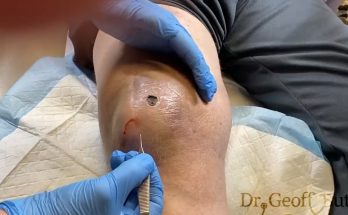This image shows an extreme case of earwax buildup, where a large, visible chunk of hardened earwax has been removed from someone’s ear, highlighting the potential for significant wax accumulation if not properly managed, which can lead to hearing issues and discomfort; it is crucial to consult a healthcare professional for safe earwax removal, especially when dealing with such large quantities; never attempt to remove large amounts of earwax yourself using sharp objects.
-
Significant buildup:
The amount of earwax shown is considerably larger than what is typically considered normal, indicating a potential blockage.
-
Importance of professional cleaning:
This image emphasizes the need to seek medical attention for earwax removal, especially when dealing with large quantities.
-
Potential causes:Factors like excessive earwax production, narrow ear canals, or improper ear cleaning habits can contribute to such buildup.6 things you need to know about earwax removal
Earwax (also called cerumen) is your ear’s natural protectant. But it can be tricky. Earwax can interfere with hearing, cause infections and be downright uncomfortable. Many people think it’s dirty and can’t fight the urge to clean it out, especially if they feel or see it.
But removing or dislodging earwax when there isn’t a medical issue can cause problems deep within your ear. To help you navigate the do’s and don’ts of earwax and ear cleaning, we’ve put together six facts you should know:
1. Earwax is important
Your ear canal has tiny hair and glands that naturally secrete waxy oil. Earwax protects the canal and inner ear as a moisturizer, lubricant and water repellant.
When you use your jaw to talk or chew, the motion helps move the wax toward your ear’s outer opening, where it can drain out. Along the way, the wax gathers and removes harmful dirt, cells and dead skin that can lead to infection.
2. Most people don’t need to clean their ears
Unless the wax in your ears forms a blockage, you shouldn’t have to go out of your way to clean them. Once earwax naturally moves toward the opening of the ear canal, it typically falls out or washes away.
Washing your hair is usually enough to remove the wax on your ear’s surface. During a shower, a small amount of warm water enters the ear canal and loosens any wax accumulated there. Use a damp washcloth to wipe away any wax outside your ear canal.
3. Impacted earwax can be painful
About 5% of adults have excessive or impacted earwax. Some people naturally produce more earwax than others. And earwax that doesn’t move quickly or gathers too much dirt along the way can get hard and dry. Other people produce an average amount of wax, but it can get impacted when earbuds, earplugs or hearing aids interrupt the natural flow.
No matter why it builds up, impacted earwax can affect your hearing and cause discomfort. If you have impacted earwax, you may experience symptoms including:
- Ear aching
- Ringing in the ear
- Impaired hearing
- Odor
- Dizziness
- Coughing
4. Cotton swabs can be bad for your ears
You may be tempted to grab a cotton swab and go to work removing wax as soon as you see or feel it. But you are likely doing more harm than good. Using cotton swabs can:
- Disrupt the tiny hairs that protect the ear canal
- Push wax deeper into the ear canal
- Traumatize the fragile ear canal skin and lead to infection or bleeding
Cotton swabs can help clean the outside of the ear. Just be sure not to insert them into the ear canal.
5. Health care providers can safely remove impacted earwax
Earwax removal is the most common otolaryngologic (ear and throat) procedure performed by primary care physicians (PCPs) in the United States. Your physician knows how to soften and safely remove earwax using special instruments such as a wax spoon, suction device or ear forceps — a long thin tool used to grab earwax.
6. There are safe ways to remove earwax at home
If earwax build-up is common for you, your health care provider may recommend removing it regularly at home before it becomes impacted. You can remove earwax safely at home with:
Softening drops
Over-the-counter ear drops — which often contain hydrogen peroxide as the main ingredient — can help soften hardened wax. Your physician can tell you how many drops to use each day and how many days to use them.
Your PCP may advise against using ear drops if you have:
- A history of recurrent ear infections
- Holes in your eardrums
- Prior ear surgery
Ear irrigation
Irrigating (gently rinsing) your ear canal can reduce the risk of earwax impaction. It involves using a rubber bulb syringe to squirt water or a saline solution into the ear canal. When the water or solution drains out of the ear, it also flushes out loose ear wax.
Use wax-softening ear drops before rinsing out your ear for the best results. And be sure to warm the solution to your body temperature. Cold water can stimulate the vestibular nerve (related to motion and position) and cause dizziness. If you still have symptoms of earwax impaction after flushing your ear, contact your PCP.
Take the Next Step
If your earwax is causing pain or discomfort, reach out to your primary care physician.


